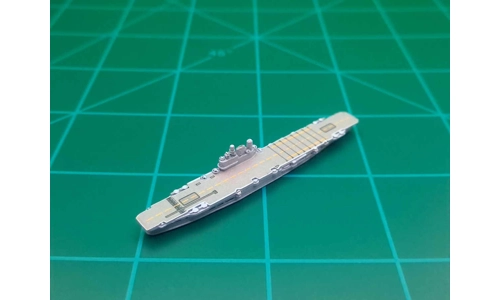
Illustrious Class
Product Details
- Illustrious Class
- CV-ILLUSTRIOUS-EM-P
-
- Units in Stock: 4
Illustrious Class Summary
This is a 3D printed sculpt of the Illustrious class aircraft carrier by EBard ModelsThe Illustrious class ships were laid down in the late 1930s as part of the rearmament of British forces in response to the emerging threats of Nazi Germany, Fascist Italy and Imperial Japan.
The class consisted of 4 members - HM Ships Illustrious, Formidable, Victorious and Indomitable - with the final ship being built to a modified design that included a second, half-length, hangar deck below the main hangar deck.
The Illustrious class was designed within the restrictions of the Second London Naval Treaty, which limited carrier size to an upper limit of 23,000 tons.
The contrast with US carrier design is evident: US design emphasised large air groups as the primary means of defence, wherease the Illustrious class relied on their anti-aircraft armament and the passive defence provided by an armoured flight deck for survival, resulting in a reduced aircraft complement. Other carriers had armour carried on lower decks but the unprotected flight deck and the hangar below it formed part of the superstructure, and were unprotected against even small bombs. This allowed the hangar to be made larger and thus more aircraft could be carried. The main differences in aircraft capacity between these carriers and US carriers is largely due to the extra 100-foot overall length of the US designs, and the USN's operational doctrine, which allowed for a permanent deck park of aircraft to augment their hangar capacity. The Enterprise typically carried 30% of her aircraft capacity in her deck park. Indomitable's two hangars were actually larger than Enterprise's, but she carried fewer aircraft because she did not have a large permanent deck park. In 1944/45 RN carriers began to carry a permanent deck park of similar size to their USN counterparts, and this increased their aircraft complement from 36 to an eventual 57 aircraft in the single-hangar carriers, and from 48 up to 81 in the double-hangar Implacable design, compared to 90–110 for the 27,500-ton US Essex class.
In the Illustrious class, armour was carried at the flight deck level—which became the strength deck—and formed an armoured box that was an integral part of the ship's structure. However, to make this possible without increasing the displacement it was necessary to reduce the overhead height of the hangars which restricted operations with larger aircraft designs, particularly post-war. This design philosophy was different from their predecessor, the HMS Ark Royal, and the American Yorktown and Essex classes.
The armour scheme was designed to withstand 1,000 pound bombs (and heavier bombs which struck at an angle); in the Home and Mediterranean theatres it was likely that the carriers would operate within the range of shore-based aircraft, which could carry heavier bombs than their carrier-based equivalents. The flight deck had an armoured thickness of 3 inches, closed by 4.5-inch sides and bulkheads. There were 3-inch strakes on either side extending from the box sides to the top edge of the main side belt, which was of 4.5 inches. The main belt protected the machinery, petrol storage, magazines and aerial weapon stores. The lifts were placed outside the hangar, at either end, with access through sliding armoured doors in the end bulkheads.
Later in the war it was found that bombs which penetrated and detonated inside the armoured hangar could cause structural deformation, as the latter was an integral part of the ship's structure.
Pre-war doctrine held that the ship's own firepower, rather than its aircraft, were to be relied upon for protection, since in the absence of radar, fighters were unlikely to intercept incoming attackers before they could release their weapons. Accordingly, the Illustrious class was given an extremely heavy Anti-Aircraft armament. The armament was similar to Ark Royal with twin 4.5 inch turrets (in a new "between-decks" or countersunk design) arranged on the points of a quadrant. The guns were mounted sufficiently high so that they could fire across the decks; de-fuelled aircraft would be stowed in the hangar for protection during aerial attack. The Illustrious Class were fitted with four HACS controlled High Angle Director Towers, for fire control of her 4.5" guns. Illustrious pioneered the use of Radar to vector carrier borne fighters onto attacking or shadowing aircraft, and a Fairey Fulmar fighter from Illustrious achieved the first radar directed kill on 2 September 1940.[7]
These ships participated in the the major engagements of the war. Victorious took part in the pursuit of the German battleship Bismarck, Illustrious and Formidable played prominent parts in the battles in the Mediterranean during 1940 and 1941 and all three took part in the large actions of the British Pacific Fleet in 1945.
Victorious received a eight-year-long reconstruction between 1950 and 1957 to enable her to operate Cold War-era jet aircraft and was retired in 1968. The other ships were scrapped in the 1950's.
Ships in the class:
- Illustrious - Heavily damaged but survived the war
- Formidable - Heavily damaged, but survived the war
- Victorious - Survived the war
- Indomitable - Survived the war
The optional damage marker by Combat Miniatures makes a great game addition.

Approximate dimensions (LWH): 63 mm x 9.5 mm x 10 mm

Updating Order Details
Please do not refresh or navigate away from the page!
Customer Reviews
No Reviews Posted Yet - be the first!
(write review)

